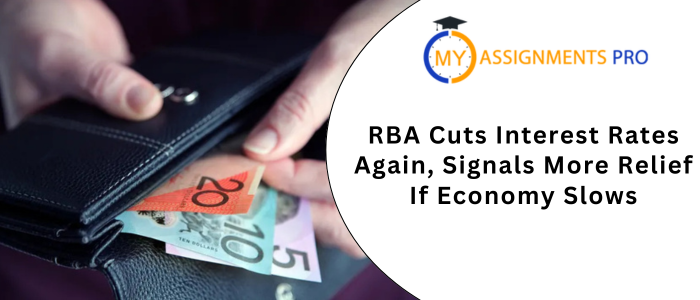
The Reserve Bank of Australia (RBA) has delivered another rate cut, lowering the official cash rate from 4.1% to 3.85%. This marks the second interest rate cut of the year, as the central bank responds to a softening domestic economy and increasing global uncertainty.
In its statement, the RBA indicated that it is prepared to cut rates again if economic conditions worsen further, signalling a cautious but responsive approach as inflation falls back into its target range.
Mortgage Relief for Households
The 0.25% interest rate cut is already being passed on by the big four banks—ANZ, CBA, NAB, and Westpac—providing much-needed relief to households with mortgages. For a typical $500,000 loan, the cut translates to about $80 in monthly savings.
With the cost of living still a pressing concern for many Australians, any reduction in monthly mortgage repayments will be welcomed. However, for renters and those without a mortgage, the benefits may not be immediately felt.
Inflation Back Within Target Band
One of the key reasons behind the RBA's decision to cut rates is the steady decline in inflation. The latest Consumer Price Index (CPI) figures show that inflation has returned to the RBA’s target range of 2–3%, landing near the middle of that band during the March quarter.
The RBA also pointed to the “trimmed mean” inflation measure—a more stable indicator that strips out volatile price movements—as evidence that inflation is genuinely under control and not just the result of temporary rebates or one-off factors.
This marks the first time since 2021 that inflation has returned to the desired range, a positive development that supports the bank's more accommodative monetary stance.
A Soft Landing After Tightening
RBA Governor Michele Bullock acknowledged earlier this year that the central bank may have been “late raising interest rates” during the inflation surge. But she also emphasised the importance of not delaying cuts when they are needed.
Despite criticisms at times, the RBA appears to have struck a balance—tightening monetary policy enough to contain inflation without triggering a sharp economic downturn. While it didn’t hike rates as aggressively as some overseas central banks, it has still managed to steer inflation back toward its target.
Labour Market Remains Strong
Australia’s job market remains resilient despite higher borrowing costs and broader economic uncertainty. The unemployment rate held steady at 4.1% in the latest data, and it has hovered around 4% since late 2023.
This is below the RBA’s previous estimate of the non-accelerating inflation rate of unemployment (NAIRU), which it puts at 4.5%. In plain terms, unemployment is lower than the level typically associated with rising inflation, yet both wages and prices have remained stable.
This suggests that the labour market is strong but not overheating, giving the RBA room to ease interest rates without fear of sparking a new inflationary spiral.
Households and Businesses Turn More Cautious
Looking ahead, the RBA now expects economic growth to be weaker than previously forecast. It has downgraded its GDP growth projection for the year ending December 2025 from 2.4% to 2.1%.
Headline inflation is expected to dip to 2.1% mid-year, but climb back to 3.0% by year’s end as temporary electricity subsidies expire. Still, underlying inflation is forecast to remain around the middle of the target band through 2026.
Meanwhile, the unemployment rate is projected to rise slightly to 4.3% by the end of the year and stay there into 2026. Real household disposable income is set to grow faster than the population, suggesting some relief from the cost of living crunch may be on the horizon.
Uncertainty in the Global Economy
One of the biggest concerns for the RBA is the unpredictability of the global economic environment. Trade tensions, especially those stemming from the United States under President Donald Trump, continue to create volatility.
According to the RBA, the outlook for global economic growth has worsened due to the impact of tariffs and the unpredictable nature of international economic policy. Trump’s administration has introduced or altered trade tariffs roughly 50 times, increasing the risk of economic disruption.
These developments are likely discouraging international trade and investment, which could weigh on Australia’s export-dependent sectors. In this context, Governor Bullock noted that global trade shifts could actually prove disinflationary for Australia, potentially keeping inflation within target and allowing more rate cuts if needed.
Will Rates Fall Further?
Financial markets are already pricing in further interest rate reductions, expecting the cash rate to fall to around 3.4% by the end of 2025. However, the RBA was quick to clarify that this forecast is based on market expectations—not a guarantee from the bank itself.
What is clear is that the RBA still considers monetary policy to be “restrictive”—meaning it continues to weigh on economic growth. As long as inflation stays within the 2–3% range and the global outlook remains fragile, the RBA is likely to remain open to further cuts.
What This Means for Australians
For Australian households, especially mortgage holders, the latest rate cut provides some short-term financial relief. However, the broader message from the RBA is one of cautious optimism. Inflation is under control, the labour market is holding firm, and cost-of-living pressures could ease as real incomes improve.
At the same time, the global backdrop remains uncertain. Whether it’s trade tensions, geopolitical risks, or fluctuating commodity prices, the external environment will play a significant role in shaping the RBA’s next moves.
For now, the central bank is prepared to step in with further support if needed—offering a sense of reassurance in an otherwise unpredictable economic landscape.
Key Takeaways:
- The RBA has cut interest rates from 4.1% to 3.85%.
- Inflation is now within the RBA’s 2–3% target band.
- Unemployment remains low at 4.1%.
- Further rate cuts are possible if the economy weakens.
- Global uncertainty and trade tensions remain key risks.
Australians will be watching closely as the RBA navigates the next phase of economic recovery, hoping that lower rates will translate into greater stability, improved affordability, and sustained growth.
Affordable, Reliable Assignment Help for Every Student
Struggling with tight deadlines or juggling multiple subjects? Our expert assignment help service is designed to ease your workload. From business and law to nursing, finance, and more – we deliver 100% original, well-researched work that meets your university's standards. Enjoy fast delivery, full confidentiality, and budget-friendly rates, with extra discounts for bulk orders. Let us help you stay on top of your studies without the stress. Reach out today and get the support you deserve!
Source
Mitchell
Mitchell is a seasoned Ph.D. scholar with extensive expertise gained through years of rigorous research, publication, and teaching experience. He brings a wealth of knowledge and analytical skills to tackle complex academic challenges. His work is dedicated to delivering innovative solutions, advancing knowledge, and promoting academic excellence. Proficient in research methodology, data analysis, and scholarly writing, Mitchell has contributed to peer-reviewed journals and mentored students to achieve academic success.


